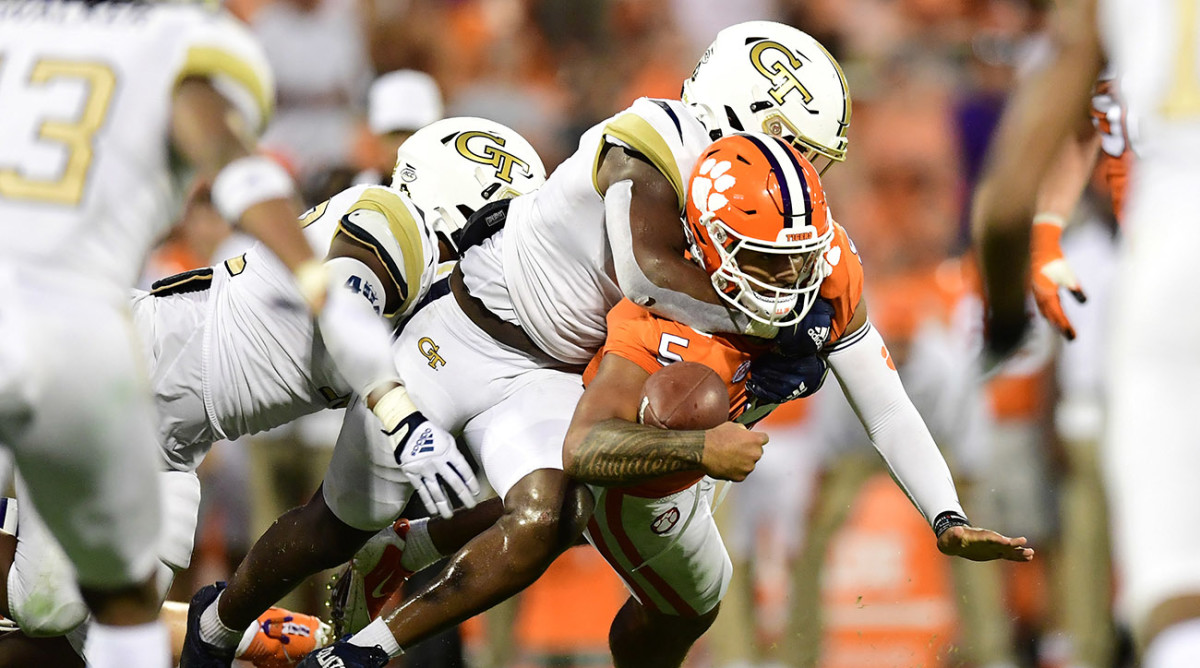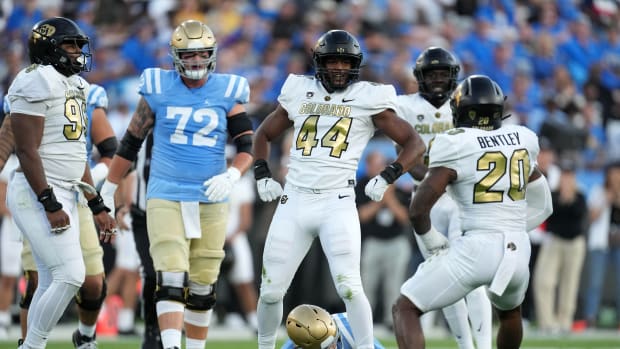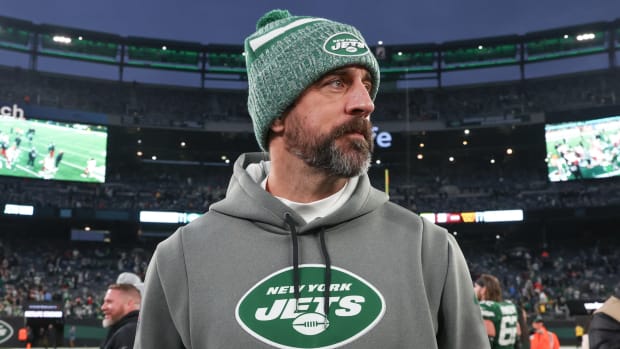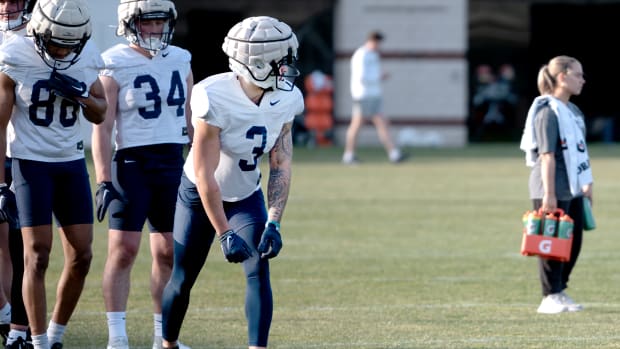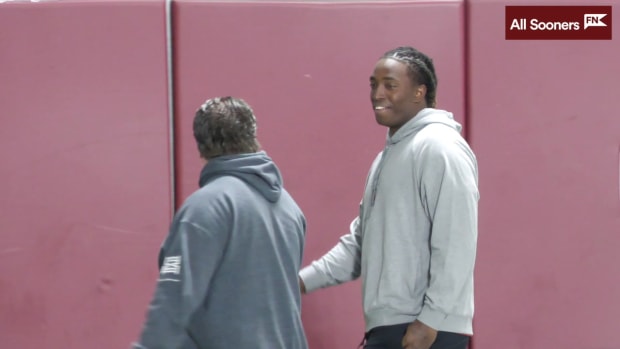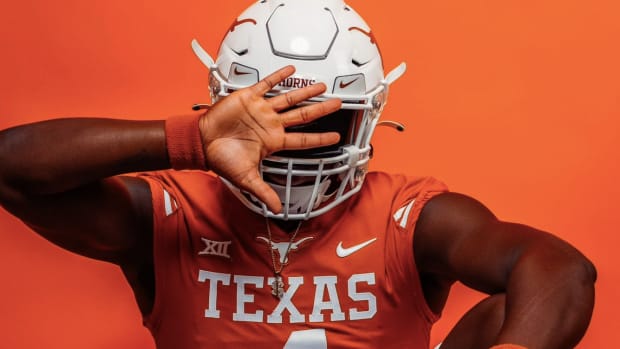Forde-Yard Dash: High-Profile QBs Facing Early Struggles
Forty names, games, teams and minutiae making news in college football (Tyler Allgeier hero punch T-shirts sold separately in Provo):
MORE DASH: Top QBs Profile | Crumbling Roadblocks | USC Stock Watch
FIRST QUARTER: THE DIFFERENCE BETWEEN STARTING QUARTERBACKS AND STARRING QUARTERBACKS
The Dash regrets to inform certain spoiled fan bases that not every highly touted quarterback who steps into a starting role is going to be a star right away. We’re seeing that now at several schools that entered the season ranked in the top 15, in no small part under the assumption that the new guy at QB would immediately play to the program’s recent high standard.
Apparently, it’s not that easy. Not every young man is ready to be The Man. And that’s one big reason some of the perennial national title contenders look more vulnerable than expected. The role call:
D.J. Uiagalelei (1), Clemson.
The hype: Uiagalelei arrived as the No. 1 pro-style quarterback in the class of 2020, according to Rivals., equipped with a cannon of an arm and noteworthy agility for someone his size (6' 4", 250.) He started two games in place of Trevor Lawrence as a freshman and lit up Boston College and Notre Dame, throwing for a combined 781 yards, four touchdowns and no interceptions in those starts. He also signed a name, image and likeness deal with Dr Pepper before the season that has given him a place in national TV ads.
The lineage: Uiagalelei is following 2021 No. 1 NFL draft pick Lawrence, who followed first-round pick Deshaun Watson. Both won national titles at Clemson and were Heisman Trophy finalists.
This season: Let’s just say big D.J. hasn’t made anyone forget Lawrence yet. His efficiency rating has plummeted from 146.39 last season to 104.88 this year, with just one touchdown pass and two interceptions, one of which was returned for the winning touchdown for Georgia. That efficiency rating is 12th out of 13 in the Atlantic Coast Conference and is outside the top 100 nationally. Through two games against FBS competition, the Tigers are averaging 8.5 points and have just two touchdowns.
After the Georgia game, coach Dabo Swinney said, "There’s nobody that cares more. Incredibly talented player. This will be one that grows him up even quicker, for sure.” Except the growing pains continued Saturday in an ugly slog against Georgia Tech. Clemson’s 14 points and 284 total yards were its fewest in both categories against an ACC opponent in seven years. The offense was so buttoned-down that Uiagalelei never got to use his big arm to take shots downfield, resulting in a measly 5 yards per pass attempt. Clemson got Uiagalelei more involved in the running game against Tech, and he produced a career-high 46 rushing yards. But he also fumbled on one run in that game, and he’s got three of the Tigers’ five giveaways through three games.
Clemson’s offensive line continues to be pedestrian at best, and Travis Etienne is missed in the backfield. The Tigers are last in the ACC in runs of 10 yards or longer from scrimmage with just 10, and they have only two of 20 yards or longer. The receiving corps hasn’t been able to break many big plays, either.
The prognosis: There’s little reason to believe Uiagalelei won’t be a star; it’s just a question of when. But if it’s not this year, there is talent coming in behind him in the person of 2022 five-star Cade Klubnik that may create a competition for the job.
C.J. Stroud (2), Ohio State.
The hype: He was the No. 3 pro-style QB in the class of 2020, two spots behind Uiagalelei, and was named the MVP of the Elite 11 camp in 2020. Stroud won Ohio State’s preseason camp battle to be the starter over other highly touted young QBs. Stroud was one of five Buckeyes who received a new car as part of an August NIL deal.
The lineage: Stroud is following Justin Fields, who was the 11th pick in the draft last spring. Before Fields was Dwayne Haskins, the 15th pick in the 2019 draft. Both were Heisman finalists.
This season: To be very clear, Stroud is not at the top of coach Ryan Day’s list of things to worry about. That remains his defense, which gave up 500 yards for the second straight game Saturday, this time to a Tulsa team that hadn’t racked up that many yards against a Power 5 opponent since 2015. Ohio State is 118th nationally in total defense. But the Buckeyes’ ability last year and previously to wallpaper over defensive shortcomings has started with its quarterback, and Stroud isn’t ready to throw it 50 times every game—even with the best receiving tandem in the country in Garrett Wilson and Chris Olave.
Watch NCAA football games online all season long with fuboTV: Start with a 7-day free trial!
Stroud’s efficiency rating has dropped every game, from 222.26 against Minnesota to 154.74 against Oregon to 127.36 against Tulsa. For the season he’s at 162.67, a perfectly fine number until you compare it to Fields’s first three Ohio State starts (184.98), or Haskins’s (192.37). Stroud has occasionally been wild high with the ball and needs to be consistent with his mechanics. As his reads improve, so will his accuracy.
The prognosis: A ground-based offense like the one the Buckeyes utilized against Tulsa, running 62% of the time, might be the best way to bring Stroud along. Goodness knows, Ohio State has running backs and linemen. Unless the Bucks get behind early (not out of the question, given the defensive issues), building around the running game and putting less on Stroud’s shoulders seems prudent.
Bryce Young (3), Alabama. The hype: Young was the No. 1 dual-threat quarterback and No. 2 overall prospect in the recruiting class of 2020. Young has NIL deals that coach Nick Saban said this summer were near “seven figures.”
The lineage: The previous three Alabama starting quarterbacks are all NFL starters: Mac Jones (New England); Tua Tagovailoa (Miami); and Jalen Hurts (Philadelphia). All three won national championships and were Heisman finalists (although for Hurts that came after a transfer to Oklahoma).
This season: Young is playing well, with 10 touchdowns and no interceptions and 804 passing yards. He hasn’t been a running threat at all (eight carries, minus-1 yard), although his mobility has kept alive plays in the passing game. Against Florida, Bama’s streak of 12 straight games scoring 40 or more points was snapped, and Young didn’t produce any plays of 30 yards or longer.
Like Stroud, his efficiency rating is going down, not up: 181.84 against Miami; 177.66 against Mercer; 147.06 against Florida. His season rating of 168.54 is perfectly respectable . . . but through three games last year, Jones was at 220.34. (To be fair, Jones also began 2020 throwing to DeVonta Smith and Jaylen Waddle, now catching touchdowns in the NFL as first-round picks. That might have been the most talented offense in college football history. Young doesn’t quite have that weaponry around him.)
The prognosis: Nick Saban isn’t spending this week worrying about his quarterback. He’s dealing with a defense that gave up 258 rushing yards against Florida, the most in seven years. Young will be just fine; the question is when (or if) offensive coordinator Bill O’Brien adds more designed QB runs to the offense.
Spencer Rattler (4), Oklahoma.
The hype: Rattler was the No. 1 dual-threat QB prospect in the nation in 2019. After getting three cameos backing up Kyler Murray that season, he was named the starting quarterback heading into last season. Rattler recently one-upped Stroud by working an NIL deal for not one but two cars.
The lineage: Rattler’s immediate predecessors as starting QBs at Oklahoma are all NFL starters (Hurts, Murray and Baker Mayfield). The latter two were both No. 1 NFL picks and Heisman Trophy winners.
This season: Rattler’s situation is different from the above QBs because he’s already had a full season of starting experience. Which makes his performance to date more tangibly disappointing. Rattler had his struggles last season, most notably a three-interception fiasco in an upset loss to Kansas State, but got everyone excited with a big Cotton Bowl performance against Florida. The expected progression from that has instead been a regression.
Rattler’s efficiency rating is 32nd nationally. Currently he’s down 14 points from last year—and last year’s rating was the lowest for an Oklahoma starter since 2014. He was pedestrian against Nebraska on Saturday, leading the Sooners to just 23 points, their fewest in a game in five years.
The prognosis: Oklahoma may yet be a playoff team, but they’re not likely to be a playoff team because Rattler is a pyrotechnic passer who lights up the Big 12 for 400 yards a game. He’s a good college quarterback. He’s not comparable to Mayfield or Murray.
Jack Coan (5), Notre Dame.
The hype: O.K., there wasn’t the same level of hype for Coan as the QBs above him on this list. Still, he wasn’t Hamburger Helper. The four-star recruit from New York was the No. 13 pro-style quarterback in the 2017 class who spent four seasons at Wisconsin before getting injured and then being nudged aside for Graham Mertz (see below). Coming to Notre Dame, he was expected to fit snugly into the Brian Kelly offensive machinery, make everyone forget that Phil Jurkovec transferred to Boston College, and keep the Fighting Irish in the Top 10.
The lineage: Coan replaces Ian Book, who went 30–5 as a starter and left Notre Dame as the winningest quarterback in school history. Book was a fourth-round draft pick of the New Orleans Saints.
This season: Truth be told, Coan has started this year slightly better than Book started last year, from a passing perspective. But he’s another QB whose efficiency rating has declined week after week, from a very sharp 194.14 against Florida State to 138.41 against Toledo to 130.11 against Purdue. Coan is nowhere near the runner Book was, having been dropped for 48 yards in losses through three games, whereas Book accounted for 79 rushing yards and four touchdowns in the first three games of 2020.
The prognosis: There are much tougher defenses to come, so Coan will be challenged more directly in the next two weeks. That starts with his old team, Wisconsin, Saturday in Chicago, then is followed by a visit Oct. 2 from Cincinnati. The Irish will need some plays from their QB to win those two.
Graham Mertz (6), Wisconsin.
The hype: Mertz was hailed as the highest-rated quarterback recruit ever at Wisconsin, a four-star guy who was the No. 2 pro-style quarterback in the class of 2019 and had offers from just about every blueblood program. An injury to Coan elevated him to the starting position last year, and he began it with a spectacular performance against Illinois and a big win over Michigan. Although Mertz’s production tailed off significantly thereafter, he was on the cutting edge of the NIL movement, producing his own logo and a clothing line, in addition to signing a deal with Raising Cane's.
The lineage: Coan was the latest in a succession of efficient-if-unspectacular Badgers quarterbacks who excelled at not getting their team beaten.
This season: Mertz picked up as nervously as he left off, with a flurry of miscues in an opening loss to Penn State. He was better against Eastern Michigan in the second game—but that was Eastern Michigan. His current efficiency rating of 109 is the lowest in more than a decade for the Wisconsin starting QB.
The prognosis: The Badgers need to emphasize their trademark downhill running game and hope that Mertz can at least be the guy most Wisconsin QBs have been over the years—steady, dependable and capable of the occasional big play without too many mistakes. Less Mertz might be more.
FOUR FOR THE PLAYOFF
The Dash selects and seeds the College Football Playoff as if today were Selection Sunday:
Orange Bowl: top seed Georgia (7) vs. fourth seed Alabama (8).
The Bulldogs (3–0) finally allowed an offensive touchdown against South Carolina, but not until their 12th quarter of action this season. They have not only been great on that side of the ball, but the passing attack continues to flourish post-Clemson. Georgia’s aerial numbers the past two games: 683 yards, nine touchdowns. Yes, from Georgia.
Next for the Bulldogs: At Vanderbilt in what could be another defensive suffocation.
The Crimson Tide (3–0) were fully tested by Florida Saturday, their closest game since losing to Auburn in November 2019. But they not only prevailed, they once again never trailed. Alabama’s streak of not trailing now stretches across 48 quarters, dating back to the third quarter against Georgia last October.
Next for the Tide: a return home to Bryant-Denny Stadium for a nonconference matchup with Southern Mississippi.
Cotton Bowl: second seed Oregon (9) vs. third seed Penn State (10).
The Ducks (3–0) had a predictable post-Horsehoe hangover for a half against Stony Brook, then snapped out and rolled. On a team that has had more than its share of September injuries, quarterback Anthony Brown didn’t play in the second half of that game after being dinged up, but coach Mario Cristobal said “We expect him to be healthy” going forward.
Next for Oregon: winless and nearly hopeless Arizona visits Eugene on Saturday.
The Nittany Lions (3–0) probably have the two best wins on paper at this point, pulling out an upset of Wisconsin in Camp Randall to start the season and then holding off Auburn Saturday night in Happy Valley. What James Franklin’s team lacks in dominance to date, it makes up for in resourcefulness and clutch play. With Ohio State vulnerable, Penn State and others in the Big Ten East have heightened hopes.
Next for Penn State: home against FCS Villanova on Saturday.
Also considered: Iowa.
MORE DASH: Top QBs Profile | Crumbling Roadblocks | USC Stock Watch
Sports Illustrated may receive compensation for some links to products and services on this website.
